Yaupon holly has been on my mind this week. I’m doing a demonstration on one tonight at a club meeting of the American Bonsai Association, Sacramento, and have been collecting notes on their care.
Since I began working on Yaupon holly – known formally as Ilex vomitoria – I’ve grown to really appreciate the variety. It’s well suited for bonsai as it has small leaves, grows fast and ramifies quickly – if you know the trick.
I started work on the Yaupon holly below 12 years ago. Here’s what it looked like before I made the first cut.
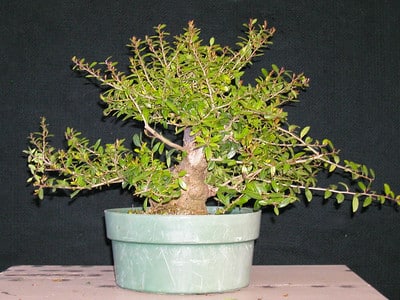
Yaupon holly, 2004
And here it is after making the first cut – a big one.
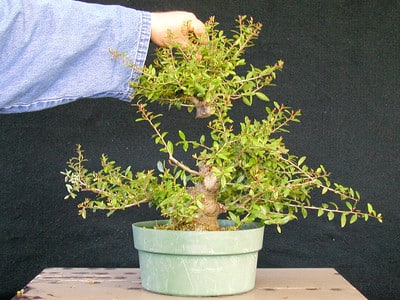
After reducing the apex
The tree wasn’t much to look at at this point. As the tree was growing in poor soil, I repotted it in Boon Mix, let it grow for several years, and by 2007 it was full again.
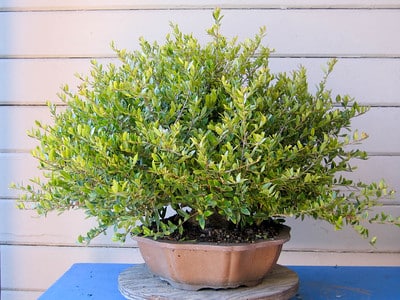
Yaupon holly, 2007
Serious work began that year when Michael Hagedorn came for a visit. Michael radically cut the tree back leaving thin shoots that could be used to create new primary branching.
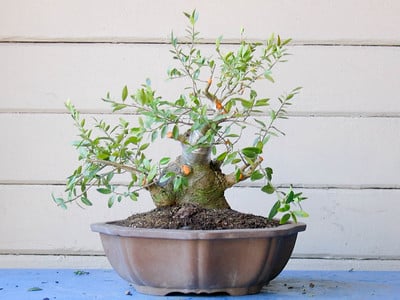
After cutback
I let the tree grow for the next two years and then reduced the branches even further, keeping only the branch sections that could be used in the final design.
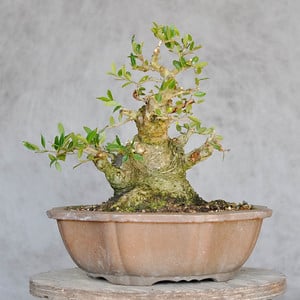
Two years later – after cutback in 2009
As you can see, there’s no significant progress here. This was the clue that there was a better way to approach Yaupon holly branch development.
Boon Manakitivipart and I had found that reducing the branches dramatically caused lots of new shoots to emerge. What we needed, at this stage of development, was a smaller number of shoots that would elongate enough to begin thickening the branches.
The next year, Boon suggested thinning the tree instead of shortening all of the branches. I gave it a try. Here’s the tree before thinning.
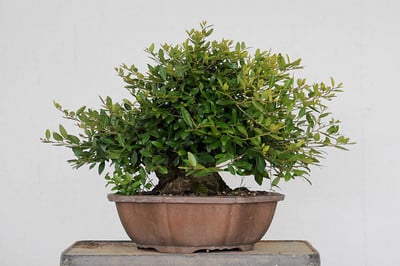
Yaupon holly – March, 2010
And here is the tree after thinning.
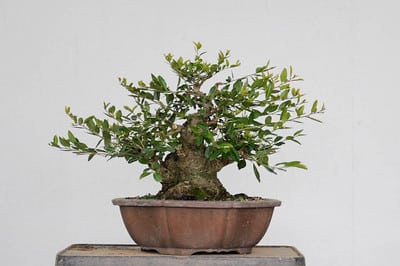
Yaupon holly after thinning
Note that the tree didn’t look like much at this point either. Leaving the branches longer gave the tree a shaggy appearance. These long branches continued, however, to lengthen which increased their size where they emerged from the trunk. This, it turns out, was the trick: to thin new growth instead of reducing it.
By December, the branches had thickened considerably – so much so that I was able to reduce them as shown below to improve branch taper and ramification.
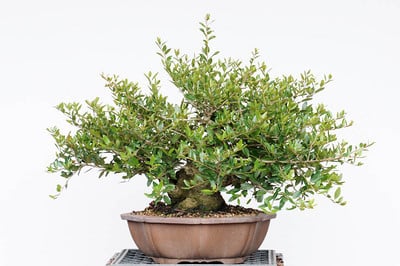
Yaupon holly – December, 2010
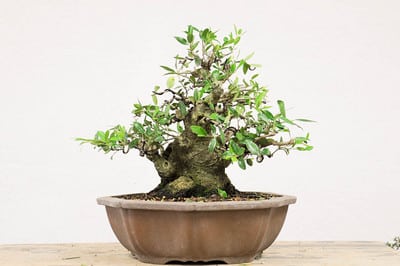
After cutback
Now that I had a repeatable process – let the branches lengthen for one to two years before reducing them – the tree developed quickly. Here’s the tree two years later.
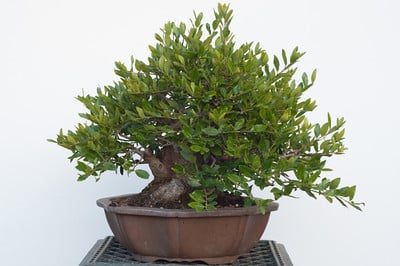
Full again – June, 2012
And here it is after cutback.
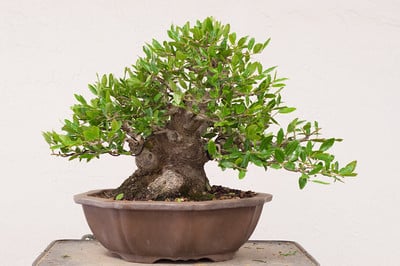
After cutback – July, 2012
This was the first time I had a sense of what the final design would look like. Just two years later, I was able to show the tree at Bay Island Bonsai’s annual exhibit – 10 years after making the first cut.
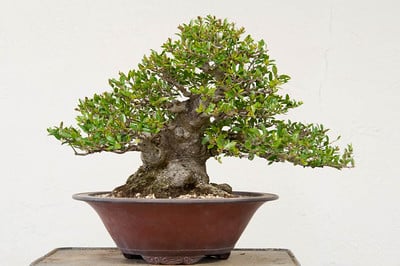
As displayed at the 2014 Bay Island Bonsai exhibit – 11″
Now that the tree is fairly well developed, maintenance is straightforward. I leave the tree alone during the growing season and thin and shorten the branches once or twice a year.
Now my biggest concern is timing cutback to get the best foliage possible for exhibits. Last summer the tree was full, but I needed to thin the foliage at least once – and possibly twice – before an exhibit scheduled for the following winter.
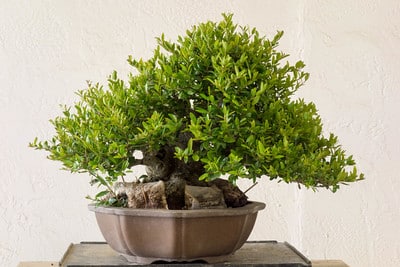
July, 2015
I knew that I could cutback 1-2 times before Bay Island Bonsai’s 2016 exhibit, depending on how quickly the tree grew that summer. I thinned the tree in July and reduced new shoots to 2-3 leaves.
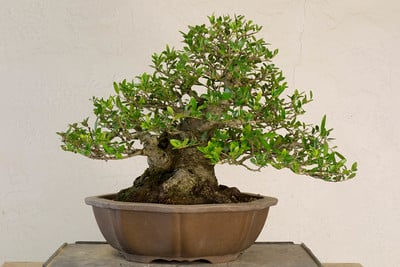
After thinning and cutback
After minor cutback in fall, the tree was ready to go this past winter.
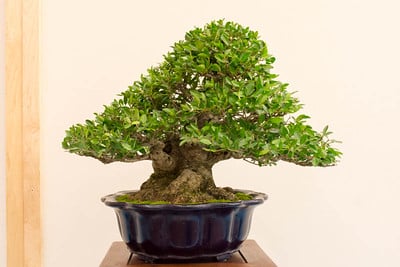
Yaupon holly as exhibited at Bay Island Bonsai’s 2016 exhibit
As I head up to Sacramento for tonight’s demonstration, I’ll be keeping in mind which branches I want to leave long and which to thin out – the main trick to developing Yaupon holly bonsai.
Subscribe to Bonsai Tonight
New Posts Delivered Every Tuesday and Friday
Karen Harkaway says
Jonas, I want to thank you for your wonderful blog. You do the bonsai world such a service every week!! I have a question about this post. The approach you are suggesting here for Yaupon holly would be the same as for most deciduous trees, correct? (I realize that the holly is a broadleaf evergreen, or semitropical)
Jonas Dupuich says
Karen – thanks so much for the note! Good question. Essentially, the technique is the same for Yaupon holly as it is for other deciduous varieties. The big difference is in timing. Whereas typically I can let deciduous trees run for a year before cutting back, I have to wait up to two years before cutting back Yaupon holly. Treating the holly the way I treat deciduous trees produced lots of tiny shoots that were too small to work with. Simply giving them more time produced the desired results.
Candace says
Jonas, I am in awe of your consistency over the years of development, keeping track of what you have done, and with photographic evidence, certainly not impossible to do, but so few people can do it. Your results prove that it is well worth the effort to develop observation skills, take excellent notes and photos and keep at it. Gorgeous tree and thank you for sharing your wisdom.
Bruce Winter says
Thanks so much for this Jonas. I have an old Yaupon holly that has been waiting for this enlightened information!
mrmurt says
Jonas, I have a question on “thinning”.
After you let the branches grow out for a while, are you thinning out the unwanted or not correctly placed growth points? Allowing the correctly placed growing points to thicken?
Second question – How does this method keep internodes at the shorter length we are looking for? Or how do you keep the first internode from being too long?
Keep up the information and insight you are sharing with us. Your kindness is remarkable.
Jonas Dupuich says
@mrmurt – good question about thinning. You’re exactly right – I’m thinning out the unwanted and incorrectly placed shoots and letting the ones that emerge from the right spots lengthen and thicken.
As for the internodes, I haven’t had to worry to much about them. In the early stages when there’s little ramification, the internodes are fairly long, but I’ve found they naturally tighten up a bit as the tree becomes more dense.
carterbeall says
Very good to note. I have heard that these are inclined to lose vigour quickly and die if the thick branching is not regularly eliminated and replaced.